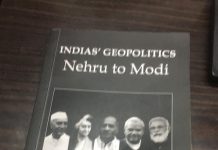Satyam founder Ramalinga Raju’s 2009 revelation that he had for years been overstating profits in a massive accounting scam sent shockwaves throughout Indian industry, and took the country’s fourth largest outsourcing firm to the brink of destruction. Zafar Anjum’s new book, The Resurgence of Satyam, is the story of how the government and industry came together to save over 50,000 jobs and the country’s reputation overseas. In an interview with Ajachi Chakrabarti, Anjum says we must wait for the next scandal in order to know if the establishment has learnt any lessons from the Satyam saga.
 The media has called Ramalinga Raju a messiah, a visionary, an old-style businessman who adapted to the new economy and a simple crook. What is your assessment of the man?
The media has called Ramalinga Raju a messiah, a visionary, an old-style businessman who adapted to the new economy and a simple crook. What is your assessment of the man?
I find him a very interesting person with shades of grey. From everyone I talked to, right from the top executives to simple employees, I got the sense that this man was held in great respect and some people even saw him as a God, as somebody who gave them a job and a life. The philanthropic work he was doing in the villages of Andhra Pradesh as well as innovations like the EMRI ambulance service also gave him a sort of halo as a messiah and do-gooder. Nobody had anything bad to speak of him. So that’s why everybody was so shocked when he revealed what he had been doing for the last eight years. My sense of him was that he was very intelligent and a great entrepreneur with great vision, but he had this darkness inside him, which he had very successfully hidden for all these years.
Do you subscribe to his version that he made a small lapse, which compounded over the years, or do you think he had planned this over all those years?
I feel that he must have started out with good intentions, and as the IT industry was making large profits, as other companies started doing really well, and as his company was unable to show similar results, he did this because it was very important for him to get good value for the shares he held in the company. For that, he had to show very good results, and that is when he started fudging the numbers. He has admitted that it started small, but the hole kept getting bigger and bigger, so the lie had to be magnified as the company rode the wave of success. On the way, he probably thought that he could cover it up by buying out the two companies (Maytas Infrastructure and Maytas Properties), but when that did not work out, he realised there was no way out (but to confess). I believe, and many people I spoke to believe, that if the merger had gone off and alarm bells not sounded, nobody would have known anything and he would have successfully covered it up.
Do you think the Indian media deliberately ignored Raju’s scam, and was this symptomatic of a general blind spot that the media affords corporate India to get away with murder for the sake of projecting a certain image of India Inc?
Yeah, I believe that with the kind of journalism that the media has done in the political and social space, the same kind of focus has not gone into the business field. It is happening now, with the Radia tapes and other disclosures, but even these might be happening because of some vested interests. A dispassionate attitude towards covering business practices is missing from the media, and they are not unearthing scams like their counterparts in the West. There is a very cosy relationship between business journalists and business houses, and the distance that one should observe is not present.
Are we better prepared today to detect such scams in the future, rather than inchoately dealing with crises when they come up?
I think it depends on the company’s culture. The Satyam scam made all businesspeople in India aware that they need to have better corporate governance, ensure compliance with all rules and regulations and put checks and balances in place. This is what Mahindra did when they took over Satyam.
But what about the regulators? Self regulation is well and good, but are the regulators better equipped to detect corruption now?
I don’t know. They will always say that they have learnt lessons from Satyam and will do whatever needs to be done, but their efficacy ultimately depends on them. I can’t speak on their behalf. Unless and until we stumble upon another scandal, we don’t know.
Of course, your book deals with how Satyam pulled together and survived, something you attribute to a certain ‘Spirit of Satyam’. In a nutshell, what is this spirit, and how does it differentiate the company from others?
The spirit of Satyam is more of a metaphor, I would say. It came from a canvas picture that I had seen in the immediate aftermath of the crisis. Two or three days after Raju’s confession, I saw a photo of Satyam employees putting their handprints on the canvas and writing messages (in support of) the company. The canvas had a phrase in big letters: “Spirit of Satyam”. The image stayed with me; at that time, nobody knew what was going to happen to the company. When I met all these people, I got the sense that there was a lot of commitment and devotion among these employees for the company. Even though many employees applied on online job portals, a lot of them said they did not want to jump ship, that they were going to stick together. That is why, on the day the scandal broke, all the regional leaders of Satyam issued a joint statement that they were with the company and had to take it forward. A lot of regular employees were working in client spaces and premises, not in the company headquarters, and irrespective of whatever happened to the company, they believed that they had to keep on working and delivering services. When I am alluding to this spirit of Satyam, I am talking about all these qualities.
Would you say that the creator of this spirit was Raju himself?
I would. He was like a prophet, you know; he had his own theories and philosophy of management. He had this thing called The Satyam Way, a 250-page book that used to be distributed to the employees, which enumerated the qualities of a good manager and how Satyam would do business. He was committed to the company, and from Day One, he was hiring and nurturing people. He had a big leadership school, he had brought in people from abroad to train the next generation of leaders. So all these things helped put in place this spirit of Satyam.
Even with this spirit of Satyam, the company couldn’t have survived without the extraordinary support from the government, could it? Was such support by the government for an independent corporation that had perpetrated such a scam justified?
Yeah, I think so, because if the government had not stepped in, the company would definitely have imploded. And it was not the case of just one company; it was about the whole Indian IT industry and how it was going to be perceived abroad. People abroad would have thought that if one Indian company is such a big fraud, what about the others? You know how much outsourcing the IT industry provides business and employment to India. I applaud the government’s intervention since it did not spend any money from its pocket. They did not bail it out, but helped it stay on course and not implode. It was a question of more than 50,000 people losing their jobs.
Why did you call the aftermath of this crisis “corporate India’s finest moment”?
Nowhere else in the world have we seen this kind of example when a company goes to the brink of destruction and comes back in a heartbeat. This is also a fine case of public-private partnership, and they came together to save such a company, which was at that time India’s fourth largest outsourcing firm. The kind of doom and gloom its impending destruction created and the way it was salvaged was noticed around the world, and that is why this was one of corporate India’s finest moments.
Ajachi Chakrabarti is a Correspondent with Tehelka.
ajachi@tehelka.com












